Ad
CSS :has() Unlimited Power
- 1. Eric Meyer Developer Advocate, Igalia Co-founder, An Event Apart CSS :has() Unlimited Power
- 2. Eric Meyer Developer Advocate, Igalia Co-founder, An Event Apart CSS :has() Unlimited Power
- 3. 1996 CSS1
- 4. 1998 CSS2
- 6. CSS1 CSS2 element, .class., #id element, .class, #id, [attr], a > b, a + b, … a > b
- 7. a > b
- 8. a b >
- 9. a b <
- 12. “The problem is that browsers cannot store all of the information they need to know exactly what to invalidate when something in the DOM changes. They end up using a tainting model that inevitably (in the worst case scenarios) leads to over-invalidation.” shauninman.com/archive/2008/05/05/css_qualified_selectors#comment_3942
- 13. BROWSER VENDORS
- 14. vimeo.com/223432117 vimeo.com/286945944 Solving container queries today Contain Your Excitement
- 15. vimeo.com/223432117 vimeo.com/286945944 Solving container queries today Contain Your Excitement
- 19. +
- 20. :has()
- 24. p:has(a) p:has(> img) <p> <a href="…">…</a> </p> <p> <span> <a href="…">…</a> </span> </p> <p> <span> <span> <a href="…">…</a> </span> </span> </p> <p> <img src="…" alt="…"> </p> <p> <span> <img src="…" alt="…"> </span> </p> <p> <span> <span> <img src="…" alt="…"> </span> </span> <img src="…" alt="…"> </p>
- 28. *:has(+ script.adjs) <div> …(ad markup here)… </div> <script class="adjs"> … </script> <div> …(ad markup here)… </div> <main> …(main content)… </main> <script class="adjs"> … </script> <main> …(main content)… </main> <div> …(ad markup here)… </div>
- 29. div:has(> script) + *.advert <div> <script class="adjs"> … </script> </div> <iframe class="advert"> … </iframe> <iframe class="advert"> … </iframe>
- 30. div:has(> script) + *.advert <div> <script class="adjs"> … </script> </div> <img src="…" alt="…"> <iframe class="advert"> … </iframe>
- 31. div:has(> script) + *:has(*.advert) <div> <script class="adjs"> … </script> </div> <div> <div class="advert">…</div> </div> <div> <div class="advert">…</div> </div>
- 32. *:has(script.adjs) > * <header> <div class="advert"> … </div> <img src="…" alt="…"> <script class="adjs"> … </script> </header> <div class="advert"> … </div> <img src="…" alt="…"> <script class="adjs"> … </script>
- 37. <body> <div id="layout"> <main> </main> </div> </body> <div> <div> <div aria-label="Sponsored"> </div> </div> </div> div:has( [aria-label="Sponsored"])
- 38. Invalid :has()
- 39. main:has(div:has( + script)) Invalid :has() :has() INSIDE :has()!!!
- 40. main:has(div::before) Invalid :has() a pseudo-element inside :has()!!!
- 41. ::slotted(p:has(img)) Invalid :has() :has() inside a pseudo-element!!!
- 42. p::first-line:has(img) Invalid :has() :has() following a pseudo-element!!!
- 43. p:has(a[href]:visited) Limitation on :has() :visited can NEVER be selected
- 44. Performance?
- 45. vimeo.com/223432117 vimeo.com/286945944 Solving container queries today Contain Your Excitement
- 46. <div> <h3>High-Quality Baseball Cap</h3> <img src="…" alt=""> <p class="price"> <del>$40</del> $25 <small>(40% off)</small> </p> <a href="…">Sizing chart</a> <p class="sale">Sale</p> <p class="coupon">Save an extra 20% with code: SCORE</p> </div> Performance?
- 47. <div> <h3> <img src="…" alt=""> <p class="price"> <del> <small> <a href="…"> <p class="sale"> <p class="coupon"> Performance?
- 48. Performance? div h3 img src="…" alt="" p class="price" del small a href="…" p class="sale" p class="coupon"
- 49. Performance? div h3 img src="…" alt="" p class="price" del small a href="…" p class="sale" p class="coupon"
- 50. Performance? div h3 img src="…" alt="" p class="price" del small a href="…" p class="sale" p class="coupon" div .sale
- 51. Performance? div h3 img src="…" alt="" p class="price" del small a href="…" p class="sale" p class="coupon" div p del
- 52. Performance? div h3 img src="…" alt="" p class="price" del small a href="…" p class="sale" p class="coupon" div:has(p del)
- 53. Performance? div h3 img src="…" alt="" p class="price" del small a href="…" p class="sale" p class="coupon" div:has(p del) del
- 54. div h3 img src="…" alt="" p class="price" del small a href="…" p class="sale" p class="coupon" div:has(p del) p del Performance? !
- 55. div h3 img src="…" alt="" p class="price" del small a href="…" p class="sale" p class="coupon" div:has(p del) p del del Performance? !
- 56. Performance? !
- 57. Performance? !
- 58. Use Cases?
- 60. <div> <h3>High-Quality Baseball Cap</h3> <img src="…" alt=""> <p class="price"> <del>$40</del> $25 <small>(40% off)</small> </p> <a href="…">Sizing chart</a> <p class="sale">Sale</p> <p class="coupon">Save an extra 20% with code: SCORE</p> </div>
- 61. <div> <h3> <img src="…" alt=""> <p class="price"> <del> <small> <a href="…"> <p class="sale"> <p class="coupon">
- 62. <div> <h3> <img src="…" alt=""> <p class="price"> <del> <small> <a href="…"> <p class="sale"> <p class="coupon">
- 63. <div> <h3> <img src="…" alt=""> <p class="price"> <del> <small> <a href="…"> <p class="sale"> <p class="coupon"> .sale .sale .coupon .sale .coupon
- 64. .coupon .sale .sale .sale .coupon <div> <h3> <img src="…" alt=""> <p class="price"> <del> <small> <a href="…"> <p class="sale"> <p class="coupon">
- 65. .gallery > div:has(.sale) { box-shadow: 0.25em 0.25em 0.33em #BBB; border-color: #D00; border-width: 2px; } .coupon .sale .sale .sale .coupon
- 66. .gallery > div:has(.coupon) { box-shadow: 0 0 1em #BCB inset; } .coupon .sale .sale .sale .coupon border-width: 2px; }
- 67. .gallery > div:has(.sale):has(.coupon) { box-shadow: 0.67em 0.67em 0.75em #999; border-width: 4px; outline: 3px solid #070; } .coupon .sale .sale .sale .coupon box-shadow: 0 0 1em #BCB inset; }
- 68. .gallery > div:has(.sale, .coupon) { box-shadow: 0.67em 0.67em 0.75em #999; border-width: 4px; outline: 3px solid #070; } .coupon .sale .sale .sale .coupon
- 69. .gallery > div:has(.sale):has(.coupon) { box-shadow: 0.67em 0.67em 0.75em #999; border-width: 4px; outline: 3px solid #070; } .gallery > div:has(.coupon) { box-shadow: 0 0 1em #BCB inset; } .gallery > div:has(.sale):has(.coupon) { box-shadow: 0.67em 0.67em 0.75em #999; border-width: 4px; outline: 3px solid #070; } .coupon .sale .sale .sale .coupon
- 70. <div> <h3> <img src="…" alt=""> <p class="price"> <a href="…"> .coupon .sale .sale .sale .coupon <p class="sale"> <p class="coupon"> <div class="offers">
- 71. .coupon .sale .sale .sale .coupon .gallery div:has(.sale):has(.coupon) { box-shadow: 0.67em 0.67em 0.75em #999; border-width: 4px; outline: 3px solid #070; } .gallery div:has(.coupon) { box-shadow: 0 0 1em #BCB inset; } .gallery div:has(.sale):has(.coupon) { box-shadow: 0.67em 0.67em 0.75em #999; border-width: 4px; outline: 3px solid #070; } > > >
- 72. .coupon .sale .sale .sale .coupon .gallery div:has(.sale):has(.coupon) { box-shadow: 0.67em 0.67em 0.75em #999; border-width: 4px; outline: 3px solid #070; } .gallery div:has(.coupon) { box-shadow: 0 0 1em #BCB inset; } .gallery div:has(.sale):has(.coupon) { box-shadow: 0.67em 0.67em 0.75em #999; border-width: 4px; outline: 3px solid #070; }
- 73. html:has(.about-page) { background: hsl(50deg,15%,93%); } body:has(nav.subnav) header.page { margin-block-end: 0; } .hero:has(a[href]):has(.buy) { padding: 1em; background: #FAA; }
- 74. html:has(.about-page) { background: hsl(50deg,15%,93%); } html head body class="about-page" header … main … footer … html head body header … main class="about-page" … footer …
- 75. body:has(nav.subnav) header.page { margin-block-end: 0; } html head body header class="page" nav class="subnav" … main … footer … html head body header class="page" … nav class="subnav" … main … footer …
- 76. .hero:has(a[href]):has(.buy) { padding: 1em; background: #FAA; } header class="hero" h1 a href="…" div span class="buy" span class="sale" header class="hero" h1 a href="…" class="buy" div span class="sale"
- 77. div:has(table.data) + div:has(h2, h3) { margin-block-start: 25vh; } div:has(:not(img)) { padding-inline: 0.5rem; } div:not(*:has(*:not(img))) { border: 1px solid currentColor; }
- 78. h4:has(+ blockquote) { border-bottom: 1px solid orange; } h4:has(+ blockquote > p) { border-width: 3px; }
- 79. nav a:has(~ .current)::after { content: " > "; }
- 80. tbody:has(> tr:nth-child(7)) > tr:nth-child(odd) { background: silver; } { } 6 7
- 81. ul { margin-block: 1em; } ul:not(:has(> li:nth-child(4))) { margin-block: 2em; }
- 82. ul:has(> li:nth-child(4)) { margin-block: 1em; } ul { margin-block: 2em; }
- 83. .card:has(*:focus) { outline: 3px solid red; } article:has(> *:target) { outline: 3px solid red; }
- 84. label:has(+ :required) {font-weight: bold;} form:has(*:invalid) {background: #FAA;} label:has(+ :required:invalid) {color: red;}
- 85. label:has(+ :required)::after {content: " *";} <form> <label for="emailF">E-mail address </label> <input id="emailF" type="email" placeholder="[email protected]" required /> <label for="phoneF">Phone number </label> <input id="phoneF" type="tel" /> label:has(+ :required) {font-weight: bold;} label:has(+ :required:invalid) {color: red;}
- 86. a:has(> img) { text-decoration: none; } <a href="…"> <img src="…" alt="Home" /> </a> <a href="…"> Download <img src="…" alt="" /> </a>
- 88. Eric Meyer Developer Advocate, Igalia Co-founder, An Event Apart CSS :has() Unlimited Power






![CSS1
CSS2
element, .class., #id
element, .class, #id,
[attr], a > b, a + b, …
a > b](https://image.slidesharecdn.com/talk-17-edit-250305161943-1f058fd5/85/CSS-has-Unlimited-Power-6-320.jpg)









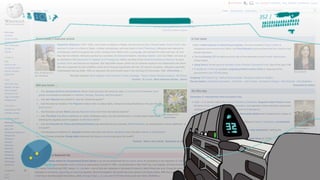











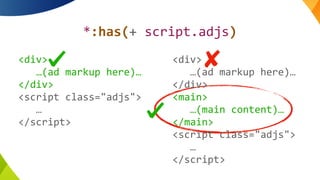




![div:has([aria-label="Sponsored"])
<body>
<div id="layout">
<main>
</main>
</div>
</body>
<div>
<div>
<div aria-label="Sponsored">
</div>
</div>
</div>](https://image.slidesharecdn.com/talk-17-edit-250305161943-1f058fd5/85/CSS-has-Unlimited-Power-33-320.jpg)
![div:has([aria-label="Sponsored"])
<body>
<div id="layout">
<main>
</main>
</div>
</body>
<div>
<div>
<div aria-label="Sponsored">
</div>
</div>
</div>](https://image.slidesharecdn.com/talk-17-edit-250305161943-1f058fd5/85/CSS-has-Unlimited-Power-34-320.jpg)
![div:has([aria-label="Sponsored"])
<body>
<div id="layout">
<main>
</main>
</div>
</body>
<div>
<div>
<div aria-label="Sponsored">
</div>
</div>
</div>
{display: none;}](https://image.slidesharecdn.com/talk-17-edit-250305161943-1f058fd5/85/CSS-has-Unlimited-Power-35-320.jpg)
![<body>
<div id="layout">
<main>
</main>
</div>
</body>
<div>
<div>
<div aria-label="Sponsored">
</div>
</div>
</div>
div:has([aria-label="Sponsored"])](https://image.slidesharecdn.com/talk-17-edit-250305161943-1f058fd5/85/CSS-has-Unlimited-Power-36-320.jpg)
![<body>
<div id="layout">
<main>
</main>
</div>
</body>
<div>
<div>
<div aria-label="Sponsored">
</div>
</div>
</div>
div:has( [aria-label="Sponsored"])](https://image.slidesharecdn.com/talk-17-edit-250305161943-1f058fd5/85/CSS-has-Unlimited-Power-37-320.jpg)





![p:has(a[href]:visited)
Limitation on :has()
:visited can NEVER be selected](https://image.slidesharecdn.com/talk-17-edit-250305161943-1f058fd5/85/CSS-has-Unlimited-Power-43-320.jpg)

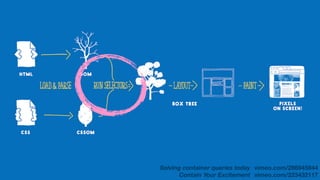

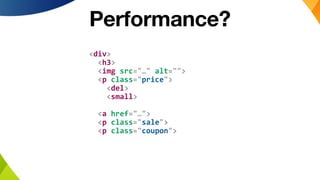











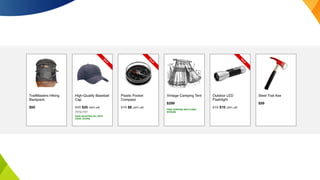

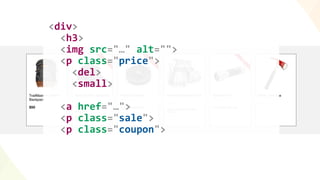






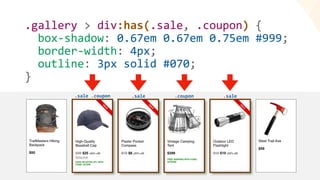




![html:has(.about-page) {
background: hsl(50deg,15%,93%);
}
body:has(nav.subnav) header.page {
margin-block-end: 0;
}
.hero:has(a[href]):has(.buy) {
padding: 1em;
background: #FAA;
}](https://image.slidesharecdn.com/talk-17-edit-250305161943-1f058fd5/85/CSS-has-Unlimited-Power-73-320.jpg)


![.hero:has(a[href]):has(.buy) {
padding: 1em;
background: #FAA;
}
header class="hero"
h1
a href="…"
div
span class="buy"
span class="sale"
header class="hero"
h1
a href="…" class="buy"
div
span class="sale"](https://image.slidesharecdn.com/talk-17-edit-250305161943-1f058fd5/85/CSS-has-Unlimited-Power-76-320.jpg)



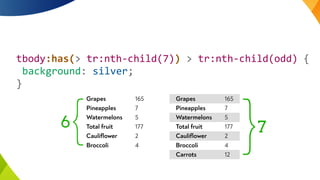
































![[edUi] HTML5 Workshop](https://cdn.slidesharecdn.com/ss_thumbnails/html5-workshop-2-111014103112-phpapp02-thumbnail.jpg?width=560&fit=bounds)

![[heweb11] HTML5 Makeover](https://cdn.slidesharecdn.com/ss_thumbnails/html5-makeover-111027112644-phpapp01-thumbnail.jpg?width=560&fit=bounds)







































